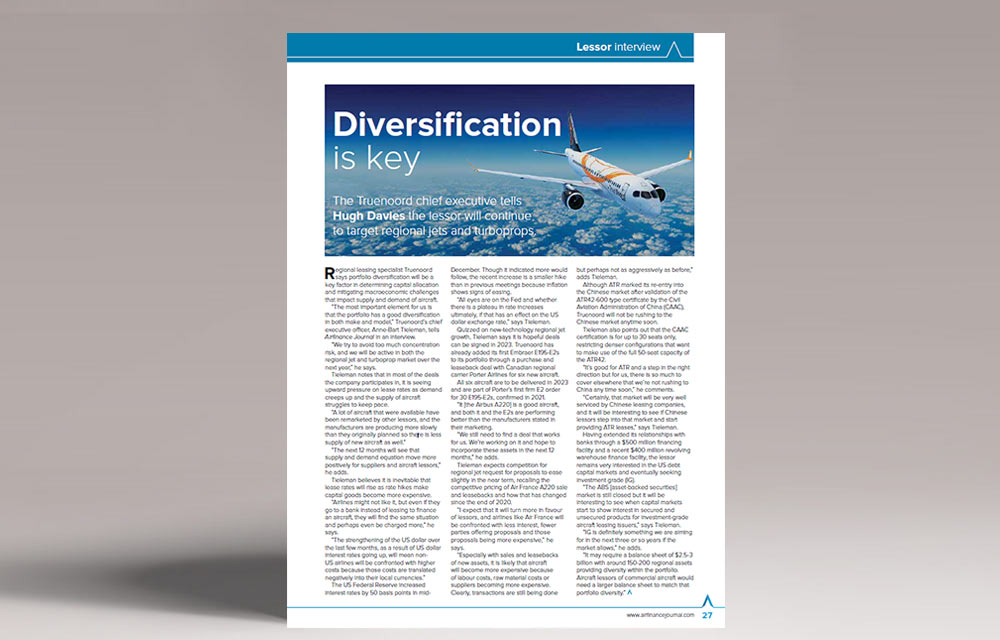
Airfinance Journal: Diversification is key
The Truenoord chief executive tells Hugh Davies the lessor will continue to target regional jets and turboprops.
Regional leasing specialist Truenoord says portfolio diversification will be a key factor in determining capital allocation and mitigating macroeconomic challenges that impact supply and demand of aircraft.
“The most important element for us is that the portfolio has a good diversification in both make and model,” Truenoord’s chief executive officer, Anne-Bart Tieleman, tells Airfinance Journal in an interview.
“We try to avoid too much concentration risk, and we will be active in both the regional jet and turboprop market over the next year,” he says.
Tieleman notes that in most of the deals the company participates in, it is seeing upward pressure on lease rates as demand creeps up and the supply of aircraft struggles to keep pace.
“A lot of aircraft that were available have been remarketed by other lessors, and the manufacturers are producing more slowly than they originally planned so there is less supply of new aircraft as well.”
“The next 12 months will see that supply and demand equation move more positively for suppliers and aircraft lessors,” he adds.
Tieleman believes it is inevitable that lease rates will rise as rate hikes make capital goods become more expensive.
“Airlines might not like it, but even if they go to a bank instead of leasing to finance an aircraft, they will find the same situation and perhaps even be charged more,” he says.
“The strengthening of the US dollar over the last few months, as a result of US dollar interest rates going up, will mean non-US airlines will be confronted with higher costs because those costs are translated negatively into their local currencies.”
The US Federal Reserve increased interest rates by 50 basis points in mid-December. Though it indicated more would follow, the recent increase is a smaller hike than in previous meetings because inflation shows signs of easing.
“All eyes are on the Fed and whether there is a plateau in rate increases ultimately, if that has an effect on the US dollar exchange rate,” says Tieleman.
Quizzed on new-technology regional jet growth, Tieleman says it is hopeful deals can be signed in 2023. Truenoord has already added its first Embraer E195-E2s to its portfolio through a purchase and leaseback deal with Canadian regional carrier Porter Airlines for six new aircraft.
All six aircraft are to be delivered in 2023 and are part of Porter’s first firm E2 order for 30 E195-E2s, confirmed in 2021.
“It [the Airbus A220] is a good aircraft, and both it and the E2s are performing better than the manufacturers stated in their marketing.
“We still need to find a deal that works for us. We’re working on it and hope to incorporate these assets in the next 12 months,” he adds.
Tieleman expects competition for regional jet request for proposals to ease slightly in the near term, recalling the competitive pricing of Air France A220 sale and leasebacks and how that has changed since the end of 2020.
“I expect that it will turn more in favour of lessors, and airlines like Air France will be confronted with less interest, fewer parties offering proposals and those proposals being more expensive,” he says.
“Especially with sales and leasebacks of new assets, it is likely that aircraft will become more expensive because of labour costs, raw material costs or suppliers becoming more expensive. Clearly, transactions are still being done but perhaps not as aggressively as before,” adds Tieleman.
Although ATR marked its re-entry into the Chinese market after validation of the ATR42-600 type certificate by the Civil Aviation Administration of China (CAAC), Truenoord will not be rushing to the Chinese market anytime soon.
Tieleman also points out that the CAAC certification is for up to 30 seats only, restricting denser configurations that want to make use of the full 50-seat capacity of the ATR42.
“It’s good for ATR and a step in the right direction but for us, there is so much to cover elsewhere that we’re not rushing to China any time soon,” he comments.
“Certainly, that market will be very well serviced by Chinese leasing companies, and it will be interesting to see if Chinese lessors step into that market and start providing ATR leases,” says Tieleman.
Having extended its relationships with banks through a $500 million financing facility and a recent $400 million revolving warehouse finance facility, the lessor remains very interested in the US debt capital markets and eventually seeking investment grade (IG).
“The ABS [asset-backed securities] market is still closed but it will be interesting to see when capital markets start to show interest in secured and unsecured products for investment-grade aircraft leasing issuers,” says Tieleman.
“IG is definitely something we are aiming for in the next three or so years if the market allows,” he adds.
“It may require a balance sheet of $2.5-3 billion with around 150-200 regional assets providing diversity within the portfolio. Aircraft lessors of commercial aircraft would need a larger balance sheet to match that portfolio diversity.”
If you’d like to download a copy of the article you can do so by clicking here
Article courtesy of Airfinance Journal: https://www.airfinancejournal.com/
10 February 2023

